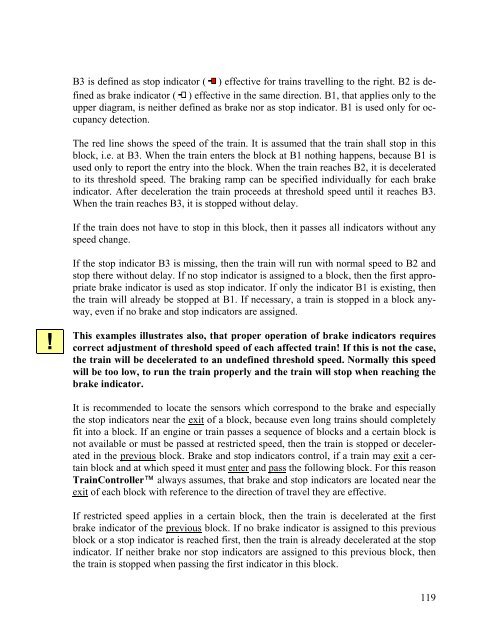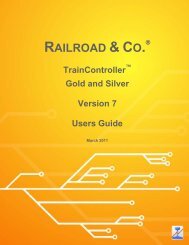Download - Freiwald Software
Download - Freiwald Software
Download - Freiwald Software
Create successful ePaper yourself
Turn your PDF publications into a flip-book with our unique Google optimized e-Paper software.
!<br />
B3 is defined as stop indicator ( ) effective for trains travelling to the right. B2 is defined<br />
as brake indicator ( ) effective in the same direction. B1, that applies only to the<br />
upper diagram, is neither defined as brake nor as stop indicator. B1 is used only for occupancy<br />
detection.<br />
The red line shows the speed of the train. It is assumed that the train shall stop in this<br />
block, i.e. at B3. When the train enters the block at B1 nothing happens, because B1 is<br />
used only to report the entry into the block. When the train reaches B2, it is decelerated<br />
to its threshold speed. The braking ramp can be specified individually for each brake<br />
indicator. After deceleration the train proceeds at threshold speed until it reaches B3.<br />
When the train reaches B3, it is stopped without delay.<br />
If the train does not have to stop in this block, then it passes all indicators without any<br />
speed change.<br />
If the stop indicator B3 is missing, then the train will run with normal speed to B2 and<br />
stop there without delay. If no stop indicator is assigned to a block, then the first appropriate<br />
brake indicator is used as stop indicator. If only the indicator B1 is existing, then<br />
the train will already be stopped at B1. If necessary, a train is stopped in a block anyway,<br />
even if no brake and stop indicators are assigned.<br />
This examples illustrates also, that proper operation of brake indicators requires<br />
correct adjustment of threshold speed of each affected train! If this is not the case,<br />
the train will be decelerated to an undefined threshold speed. Normally this speed<br />
will be too low, to run the train properly and the train will stop when reaching the<br />
brake indicator.<br />
It is recommended to locate the sensors which correspond to the brake and especially<br />
the stop indicators near the exit of a block, because even long trains should completely<br />
fit into a block. If an engine or train passes a sequence of blocks and a certain block is<br />
not available or must be passed at restricted speed, then the train is stopped or decelerated<br />
in the previous block. Brake and stop indicators control, if a train may exit a certain<br />
block and at which speed it must enter and pass the following block. For this reason<br />
TrainController always assumes, that brake and stop indicators are located near the<br />
exit of each block with reference to the direction of travel they are effective.<br />
If restricted speed applies in a certain block, then the train is decelerated at the first<br />
brake indicator of the previous block. If no brake indicator is assigned to this previous<br />
block or a stop indicator is reached first, then the train is already decelerated at the stop<br />
indicator. If neither brake nor stop indicators are assigned to this previous block, then<br />
the train is stopped when passing the first indicator in this block.<br />
119










